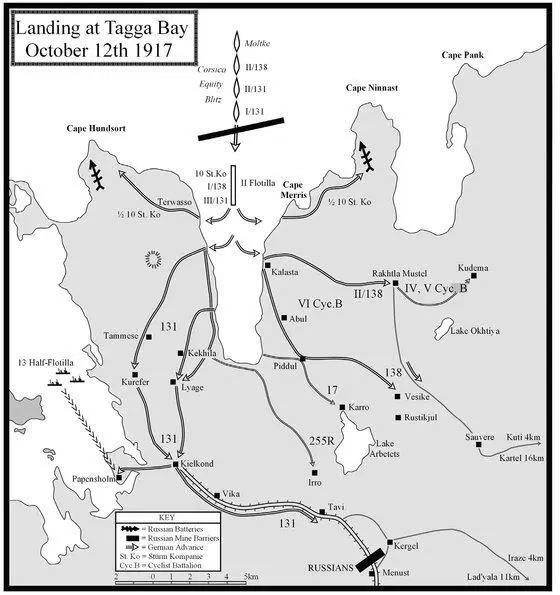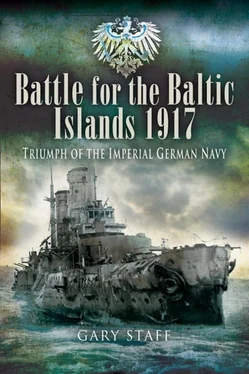Meanwhile V100 penetrated further into Tagga Bay and took course towards Terwassa, on the eastern lower half of Hundsort. Here half a sturmkompanie was landed and once ashore they directed the supporting fire of V100. With this support they quickly captured six guns of the II Light Field Artillery Battery of the 107th Division. On interrogation the commanding officer revealed that the Russians knew of the planned landing, and of the probable landing positions and had adjusted their troop dispositions to suit. Under these circumstances the Germans were amazed that the landing achieved surprise. After capturing Terwassa the assault troops turned on the battery at Hundsort, which was taken at 0830hrs.
On the eastern side of the bay the landing was also successful. The boats B109, B110, B111, B97 and B112 landed their sturmtruppen south of Cape Merris without reaction from ashore. After the assault troops were landed, 138 Regt began disembarking. Now the Half-Flotilla came under fire from a battery of field guns located behind a wood, which could not be observed. Leutnant zur See Friedrich Ruge takes up the story:
Then a white cloud appeared over the ship, and the Army Artillerist dived behind the linen bridge screen, to seek protection from the Russian shrapnel. Muzzle flashes and dense smoke behind a coppice showed the approximate area of the battery… Our stereoscopic gear could measure the range to the smoke and the guns received direction with the help of a high tree… we moved slowly to the south, at first followed by the white smoke clouds, then they stopped.
Towards 0700hrs the six gun field battery was captured by the I Battalion, 138 Regt. B112 landed assault troops of the 10 Assault Section on Cape Merris, however this landing came under heavy machinegun fire from ashore. Nonetheless, the men were thrown ashore, under the covering fire from the torpedoboats, and by 1000hrs Battery No 46 at Cape Ninnast had fallen and the Russians had retreated. The troops were able to report that the fire of the III Battle Squadron’s medium artillery had been well laid and effective. Of the four 15cm guns, one had suffered a direct hit and had been put out of action, the crew being killed, and the others had all been struck by splinters; another hit had destroyed the command position.
The landing appeared to be progressing well with the pioneers meeting only light resistance and making good progress. By around 0800hrs all the pioneers were ashore and they had secured the bridgehead. Earlier Vizeadmiral Schmidt had ordered Kontreadmiral Reuter, who lay between point Delta and point White, to quickly bring the transport fleet into Tagga Bay so that disembarking of the main body could commence. The transport fleet was preceded by the II Minesweeper Flotilla and the Sperrbrechergruppe and by 0815hrs SMS Königsberg and the I Transport Section stood off Tagga Bay. Within half an hour the first transport, Bahia Castillo , anchored and the first troops were put ashore. At 1050hrs Nürnberg and the II Transport Section arrived. The landing now proceeded swiftly; not only were the infantry disembarking but also the horses, guns and vehicles. It took just three and an half hours to land the main body of infantry. The landing and unloading work continued after darkness fell, using the searchlights from the two cruisers for illumination, so that by 2000hrs the entire infantry, their wagons and machineguns were ashore and in addition so were 530 horses and 100 vehicles.

Map 3: The Landing at Tagga Bay on October 12th 1917.
With the initial bombardments over and the arrival of the transport fleet it became necessary to secure Tagga Bay as quickly as possible. During the course of the morning it had become clearly evident that there were Russian mine barriers in areas hitherto thought safe, and therefore the chief of the II Minesweeper Flotilla was ordered to immediately begin sweeping work. Before noon the 8th Minesweeper Half Flotilla (8 MSHF) initiated a search-sweep of Tagga Bay and simultaneously began work to sweep the barrier where Corsica had been damaged. This barrier consisted of small, cylindrical, very rusty mines with three lead horns each. Next the area between Cape Ninnast and Cape Pank was swept. The 3rd Minesweeper Half Flotilla collected the III Battle Squadron and then the IV Battle Squadron and delivered them to Tagga Bay, whilst 4 MSHF collected Bayern . By 1700hrs all the heavy ships were safely anchored in Tagga Bay.
The security of Tagga Bay against submarines was the responsibility of the Net Barrier Unit of the Baltic, under the command of Korvettenkapitän Kaulhaussen. It was the first occasion that the nets were being used offensively on the enemy coast. It was planned to lay a double net square across the mouth of the bay from Cape Ninnast to Cape Hundsort, with a total length of 12 kilometers. Two gaps, which would be closed at night, would allow ships to enter and exit the bay. By 0930hrs on 12 October the net layer Rossal began laying the western part of the net, whilst an hour later Eskimo began the eastern wing. By 1550hrs Rossal had concluded her work whilst Eskimo finished her sequence at around 1900hrs. For further security against submarines a ‘listening line’ was established between Hundsort and Dagerort. This consisted of a series of trawlers fitted with hydrophones laid out at intervals.
Meanwhile the 2nd Gruppe of the 1st S-Half Flotilla were working to secure a route into Soelo Sound, which separated Dago from Ösel. Control of the Soelo sound was particularly important because the Russians could use this passage to mount a destroyer attack on the German flank. Therefore, possession of the sound was a prime consideration for the Germans, both to prevent Russian destroyer attacks and also to provide support for troops ashore, particularly those who were to take the stone dam which ran from Ösel to Moon Island. Already before dawn the A28 and her drifters had pressed forward, sweeping for mines and taking soundings as they went. When Bayern and Emden opened fire on Battery No 34 at Serro, the Russians responded by taking A28 and her boats under fire. Seven salvoes landed amongst the S-Flotilla and A28 was hit, as previously mentioned; however, after that fire was ceased. The small torpedoboat and drifters resumed their advance and succeeded in locating the narrow, buoyed channel. Whilst conducting this work, at 0812hhrs, the battery at Serro reopened fire for a short time, but was again brought to silence by Bayern . With that the I FdT dispatched S61 and S63 to silence the battery permanently, which they did during the course of the morning by landing a commando of men who removed the locks from the cannon.
After the channel through Soelo Sound had been located, the lead boat of the 2nd S-Half-Flotilla, T130, and three sweeper boats pushed forward into the Kassar Wiek, to bombard the wireless station at Pawasterort. The passage through the Soelo Sound was particularly treacherous, with many uncharted rocks and strong, difficult currents. However, even the largest Russian destroyers had utilized this passage previously for operations. Now the small German unit penetrated into the Kassar Wiek, which aerial reconnaissance had reported clear of Russian ships. Ominously, a smoke cloud soon became conspicuous to the east.
With the receipt of the first news of the appearance of enemy forces off Tagga Bay, the commander of the Naval Forces of the Riga Gulf, Vice Admiral Bakhirev, ordered all units to be at a state of half hour readiness and to refill their stocks of coal and oil. The greater part of the torpedoboats had participated in the production of defensive mine barriers off Pernau the previous day. The duty torpedoboats which were waiting in readiness, General Kondratenko and Pogranitschnik , under the command of the chief of the IV Division Torpedoboat-Destroyers, Captain 1st Rank Postelnikov, were ordered to conduct reconnaissance on the Kassar Wiek. The gunboat Grozyashchi was in Rogekul for minor maintenance and Vice Admiral Bakhirev ordered her to go to the Kassar Wiek and place herself at the disposal of the IV Division chief.
Читать дальше













